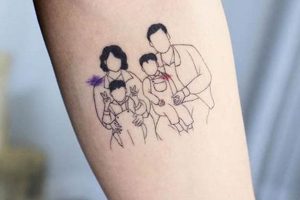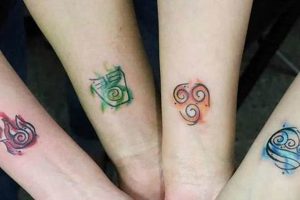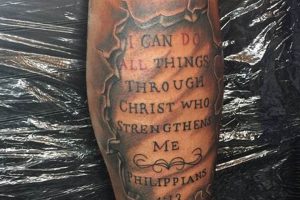Genealogical charts permanently etched onto the skin offer a unique way to showcase heritage. These visual representations can range from simple branching designs with names and dates to complex, artistic renderings incorporating symbolic imagery relevant to family history, such as crests, national flowers, or significant objects. An example might include a tree originating from a grandparent’s name with branches extending to children and grandchildren, adorned with birth flowers representing each individual.
Permanent displays of lineage offer a powerful expression of familial connection, serving as a constant reminder of one’s roots. This form of commemoration provides a deeply personal and visible tribute to ancestors. Historically, body art has signified clan affiliation and heritage across numerous cultures. This modern interpretation allows individuals to carry their family history with them, fostering a sense of belonging and identity.
The subsequent sections will explore diverse design options, from minimalist styles to elaborate depictions, along with considerations for placement, size, and the incorporation of meaningful symbolic elements. Practical advice regarding artist selection and aftercare will also be provided.
Tips for Genealogical Tattoo Designs
Careful planning ensures a meaningful and aesthetically pleasing representation of heritage. Consider these points before committing to a permanent design.
Tip 1: Research Thoroughly: Accurate genealogical research forms the foundation of a successful design. Verify names, dates, and relationships before finalizing the artwork.
Tip 2: Choose a Style: Styles range from simple, linear representations to intricate, illustrative designs. Consider personal aesthetics and the level of detail desired.
Tip 3: Select Meaningful Symbols: Incorporate elements reflecting family history, such as birthstones, crests, or significant objects, to add depth and personalization.
Tip 4: Consider Placement and Size: The body area chosen impacts the design’s layout and size. Larger areas accommodate more complex designs, while smaller areas suit simpler representations.
Tip 5: Consult with a Reputable Artist: A skilled artist specializing in this style can provide valuable design input and ensure a high-quality, lasting result.
Tip 6: Plan for Future Additions: If expanding the design later is a possibility, discuss this with the artist during the initial consultation to ensure the design allows for seamless integration of future elements.
Tip 7: Prioritize Aftercare: Proper aftercare is crucial for preserving the vibrancy and longevity of the tattoo. Follow the artist’s instructions diligently.
Careful consideration of these factors contributes to a visually compelling and historically accurate representation of one’s ancestry, creating a lasting tribute to family heritage.
By addressing these practical considerations, individuals can confidently embark on the process of creating a meaningful and enduring piece of body art reflecting their unique lineage.
1. Genealogical Research
Genealogical research forms the crucial foundation for accurate and meaningful family tree tattoos. A well-researched family history ensures the correct representation of names, dates, relationships, and ancestral origins within the design. Without this groundwork, inaccuracies can undermine the tattoo’s intended significance and create a permanent reminder of misinformation. For example, a tattoo intended to honor a specific ancestor could inadvertently misrepresent their lineage if based on incomplete or inaccurate information.
Thorough research might uncover surprising details enriching the tattoo’s narrative. Discovering an ancestor’s occupation, migration history, or notable achievements can inspire the incorporation of symbolic elements, adding layers of meaning to the design. A family crest, a symbol representing an ancestral trade, or a flower native to an ancestor’s homeland can personalize the tattoo and deepen its connection to family history. Consider a hypothetical scenario where research reveals an ancestor’s involvement in a historical event; this information could be subtly incorporated into the tattoo design, adding a powerful layer of historical context.
The depth of genealogical research directly impacts the tattoo’s authenticity and richness. While a basic family tree might represent immediate relatives, in-depth research allows for the inclusion of more distant ancestors, expanding the scope and historical context of the design. This dedication to accuracy demonstrates respect for one’s heritage and ensures the tattoo serves as a reliable visual representation of familial lineage for generations to come. Ultimately, the commitment to thorough genealogical research elevates a family tree tattoo from a simple visual representation to a powerful and accurate testament to one’s heritage.
2. Design Style
Design style significantly influences the aesthetic impact and narrative depth of genealogical tattoos. Selecting an appropriate style ensures the visual representation aligns with personal preferences and effectively communicates the intended message. The chosen style dictates the overall composition, level of detail, and incorporation of symbolic elements.
- Minimalist:
Minimalist designs prioritize simplicity and clarity, often employing clean lines, basic shapes, and limited color palettes. This style focuses on essential information, such as names and dates, presented in a streamlined format. A minimalist family tree might feature a single, unadorned trunk with branching lines representing lineage. This approach suits individuals seeking a subtle yet elegant representation of their heritage.
- Illustrative:
Illustrative styles offer greater artistic freedom, allowing for detailed depictions of individuals, objects, and symbolic elements. This approach can incorporate portraits, landscapes, or significant family heirlooms. An illustrative family tree might feature individual portraits within the branches, creating a visually rich and personalized narrative. This style suits individuals who desire a more elaborate and visually captivating representation of their ancestry.
- Abstract:
Abstract designs emphasize symbolic representation and artistic interpretation, often utilizing geometric shapes, patterns, and non-representational imagery. This style prioritizes conveying emotions and concepts rather than literal depictions. An abstract family tree might use interconnected circles or spirals to represent family connections, emphasizing the cyclical nature of life and generational continuity. This style suits individuals who appreciate artistic expression and symbolic representation.
- Watercolor:
The watercolor style mimics the soft, blended hues and fluid transitions characteristic of watercolor paintings. This approach creates a visually ethereal and artistic representation of the family tree, often incorporating vibrant colors and flowing lines. This style adds a unique artistic flair, softening the often rigid structure of traditional family tree representations. It lends itself well to designs incorporating floral motifs or other natural elements.
The chosen design style ultimately shapes the overall aesthetic and narrative of the genealogical tattoo, ensuring a personalized and meaningful representation of heritage. Selecting a style that resonates with individual preferences and effectively communicates the intended message is crucial for a successful and enduring piece of body art. By carefully considering these various design approaches, individuals can create a tattoo that reflects their unique connection to their ancestry.
3. Symbolic Elements
Symbolic elements enrich genealogical tattoos, transforming simple lineage representations into personalized narratives reflecting family history, values, and cultural heritage. These elements imbue the design with deeper meaning, creating a powerful visual representation of ancestry and identity. Careful selection and thoughtful incorporation of symbols elevate the tattoo beyond a mere chart, transforming it into a meaningful and enduring piece of art.
- Birthstones/Flowers:
Incorporating birthstones or flowers associated with each family member’s birth month adds a personalized touch. This symbolizes individuality within the larger family narrative. A ruby representing a July birth or a water lily for May adds color and visual interest while signifying individual family members’ birth months. This practice allows for easy visual identification of individuals within the family tree structure.
- Cultural/National Symbols:
Symbols representing ancestral homelands or cultural heritage connect the tattoo to broader historical and geographical contexts. A shamrock for Irish ancestry, a maple leaf for Canadian roots, or a specific tartan pattern representing a Scottish clan ties the family to their origins. These symbols provide a visual shorthand for shared heritage, strengthening the tattoo’s message of familial connection.
- Family Crests/Mottos:
Incorporating family crests or mottos, if applicable, adds historical weight and strengthens the sense of familial identity. These elements connect the individual to a lineage potentially spanning centuries. A family motto inscribed beneath the tree reinforces family values and adds a personal touch. This provides a direct link to documented family history, further enhancing the tattoo’s significance.
- Animals/Plants:
Animals or plants holding personal or cultural significance can symbolize family traits, values, or stories. A wolf might represent loyalty, an oak tree strength, or a specific flower associated with a family story could add a unique narrative layer. These symbolic representations can convey complex ideas and emotions, enriching the tattoo’s overall message. For example, a dove might represent peace, or a lion could symbolize courage, reflecting values cherished within the family.
These symbolic elements, carefully integrated into the overall design, elevate the genealogical tattoo from a simple family tree to a richly layered and deeply personal narrative. They transform a visual representation of lineage into an evocative expression of family history, values, and shared identity. By combining accurate genealogical research with thoughtful symbolic representation, individuals create a powerful and enduring tribute to their ancestry.
4. Placement
Placement plays a crucial role in the overall impact and effectiveness of genealogical tattoos. The chosen location on the body influences the design’s layout, size, and visibility, impacting both aesthetic appeal and personal significance. Consideration of body contours and available space ensures the design harmonizes with the individual’s physique and allows for optimal presentation of the family tree structure. A sprawling family tree might be best suited for the back, while a smaller, more compact design might be better placed on the forearm or calf.
Placement can also reflect the individual’s relationship with their ancestry. A tattoo placed over the heart can symbolize a deeply personal and emotional connection to one’s heritage, while a placement on the arm or wrist might represent a desire to keep ancestral connections visible and readily accessible. The visibility of the tattoo can also factor into placement decisions, allowing individuals to choose whether they prefer a more private or public display of their lineage. A tattoo on the upper arm can be easily displayed or concealed with clothing, providing flexibility in presentation. In contrast, a tattoo on the neck or hand offers a more constant and visible reminder of family history.
Practical considerations influence placement choices. Certain body areas are more susceptible to pain or distortion during the tattooing process, affecting the final result. Areas with greater muscle mass or bone density often offer a more stable surface for intricate designs, while areas with thinner skin or frequent movement might be less suitable for detailed work. The longevity of the tattoo also depends on placement; areas exposed to frequent sun exposure or friction might experience faster fading or blurring. Forearm tattoos, for instance, are more susceptible to sun damage than those placed on the back. Careful consideration of these factors ensures the tattoo remains visually appealing and meaningful for years to come. Understanding the interplay between placement, design, and individual anatomy ensures a harmonious and lasting tribute to family heritage.
5. Size
Size significantly impacts the design possibilities and overall effect of genealogical tattoos. The chosen size dictates the level of detail, number of elements incorporated, and the visual impact of the final piece. Smaller tattoos necessitate simplified designs, often focusing on essential information like names and dates, or utilizing symbolic representations rather than intricate portraits or detailed imagery. A small wrist tattoo might feature a stylized tree with initials representing family members, while a larger back piece can accommodate a more complex design with portraits, names, dates, and symbolic elements interwoven.
The size of the tattoo should align with the scope of the genealogical information being represented. A small, immediate family tree might be effectively rendered in a smaller size, while a larger, multi-generational design requires more surface area. Consider the number of individuals, dates, and other elements desired to ensure the final tattoo allows adequate space for clear representation. Cramming excessive detail into a small area results in a cluttered and less legible design, diminishing its aesthetic appeal and genealogical clarity. A large-scale tattoo allows for the inclusion of more branches, names, and details, while a smaller tattoo might focus on a single branch or a select group of ancestors.
Practical considerations also influence size decisions. Larger tattoos require longer sessions and potentially multiple appointments, impacting both cost and time commitment. Smaller tattoos, however, offer a less time-intensive and often more affordable option. Healing time also correlates with size; larger tattoos require more extensive aftercare and a longer healing period. Balancing desired design complexity with practical limitations ensures the tattoo remains a manageable and enjoyable experience from conception to completion. Choosing a size appropriate for both the design and the individual’s commitment to the process results in a well-executed and meaningful representation of family history.
6. Artist Selection
Artist selection holds paramount importance in realizing successful genealogical tattoo designs. A skilled artist translates genealogical research and design concepts into a visually compelling and technically sound piece of body art. Technical proficiency ensures clean lines, accurate details, and longevity of the tattoo. Artistic sensibility allows for creative interpretation of genealogical information, resulting in a personalized and aesthetically pleasing representation of heritage. An artist specializing in portraiture, for instance, contributes realistic depictions of ancestors within the tree design, while an artist skilled in blackwork creates a bold and impactful representation using intricate lines and shading. Choosing an artist whose style aligns with the desired aesthetic contributes significantly to the tattoo’s overall success.
Experience with genealogical tattoo designs specifically benefits the process. Artists familiar with the nuances of representing family trees understand the importance of clear layouts, effective use of symbolism, and the integration of textual elements like names and dates. This experience allows for efficient communication and collaboration between the client and artist, ensuring the final design reflects the client’s vision while adhering to sound artistic principles. An artist with experience in this niche understands the challenges of incorporating numerous elements within a cohesive design, ensuring legibility and visual balance. Researching an artist’s portfolio for examples of previous genealogical tattoo work provides valuable insight into their capabilities and artistic approach. Consulting with multiple artists allows comparison of styles and approaches, ensuring a confident selection.
Careful artist selection safeguards against potential pitfalls, such as inaccurate rendering of details, poor placement choices, or inadequate longevity of the tattoo. Investing time in research and consultation mitigates these risks, ensuring the final product becomes a source of pride rather than regret. Ultimately, the right artist transforms genealogical data into a meaningful and enduring work of art, a lasting tribute to family history and personal identity. This crucial decision ensures the genealogical tattoo fulfills its intended purpose as a powerful visual representation of heritage.
7. Aftercare
Diligent aftercare plays a vital role in preserving the aesthetic integrity and longevity of genealogical tree tattoos. These intricate designs, often incorporating fine lines, detailed script, and symbolic elements, require meticulous care during the healing process to prevent complications that can compromise the design’s clarity and vibrancy. Neglecting proper aftercare can lead to ink fading, blurring of lines, and infection, diminishing the intended visual impact and potentially obscuring the genealogical information represented.
The complexity of genealogical tattoos necessitates a tailored aftercare approach. Larger designs, covering extensive skin areas, demand more attentive care due to increased risk of infection and prolonged healing times. Intricate details, such as fine lines and small text, are particularly vulnerable to fading or blurring if aftercare instructions are not followed precisely. For example, a large back piece representing several generations of a family requires more diligent cleaning and moisturizing than a smaller wrist tattoo with a simplified design. Similarly, a tattoo featuring elaborate script detailing names and dates demands extra care to prevent ink bleeding or fading, ensuring the genealogical information remains legible.
Proper aftercare practices safeguard the investment in both the artistic design and the genealogical research underpinning the tattoo. Following the tattoo artist’s specific instructions regarding cleaning, moisturizing, and sun protection ensures optimal healing and minimizes the risk of complications. This commitment to aftercare preserves the clarity of the design, protecting the legibility of names, dates, and other genealogical details. Ultimately, meticulous aftercare ensures the genealogical tattoo remains a vibrant and accurate representation of family history for generations to come, honoring the ancestral connections it represents.
Frequently Asked Questions
Addressing common inquiries regarding genealogical tattoos provides clarity and facilitates informed decision-making. These questions cover various aspects, from design considerations to practical concerns.
Question 1: How much does a genealogical tattoo typically cost?
Cost depends on factors such as size, complexity, artist’s hourly rate, and geographic location. Smaller, simpler designs cost less than larger, more intricate pieces. Obtaining quotes from multiple reputable artists allows for cost comparison.
Question 2: How long does a genealogical tattoo take to complete?
Completion time varies based on design complexity and size. Smaller designs might require a single session, while larger, more intricate pieces might necessitate multiple sessions spanning several hours each.
Question 3: What are the best placement options for genealogical tattoos?
Optimal placement depends on design size and personal preference. Larger designs often suit the back, chest, or thighs. Smaller designs can be placed on the forearm, wrist, ankle, or behind the ear.
Question 4: How can one ensure the accuracy of genealogical information in a tattoo?
Thorough genealogical research prior to the tattoo design process is crucial. Utilizing reputable resources, such as birth certificates, census records, and family history websites, helps ensure accuracy.
Question 5: What if genealogical information is discovered after the tattoo is complete?
Consulting with the tattoo artist about potential future additions during the initial design phase allows for seamless integration of new information later. Planning for potential expansions ensures design cohesion.
Question 6: How should one choose a tattoo artist for a genealogical design?
Selecting an artist with experience in fine linework, detailed designs, and preferably prior experience with genealogical tattoos is recommended. Reviewing portfolios and seeking recommendations helps ensure artistic skill and expertise.
Careful consideration of these frequently asked questions equips individuals with the knowledge necessary to embark on the process of creating a meaningful and enduring genealogical tattoo.
The next section provides a concluding overview of key considerations and encourages further exploration of genealogical tattoo design options.
Genealogical Tattoo Designs
Exploration of genealogical charts as permanent body art reveals a powerful method for expressing heritage. Careful consideration of design styles, symbolic elements, placement, and size ensures a meaningful representation of ancestry. Thorough research forms the foundation for accuracy, while skilled artist selection and diligent aftercare guarantee a lasting tribute. These elements combine to create a visually compelling narrative, etched onto the skin, preserving familial connections across generations.
Permanent skin art offers a unique opportunity to carry one’s history. This enduring form of remembrance transcends fleeting trends, transforming genealogical research into a tangible, deeply personal expression of identity and belonging. Further exploration of individual family narratives and artistic styles allows for the creation of powerful, personalized designs, solidifying ancestral connections for generations to come.







